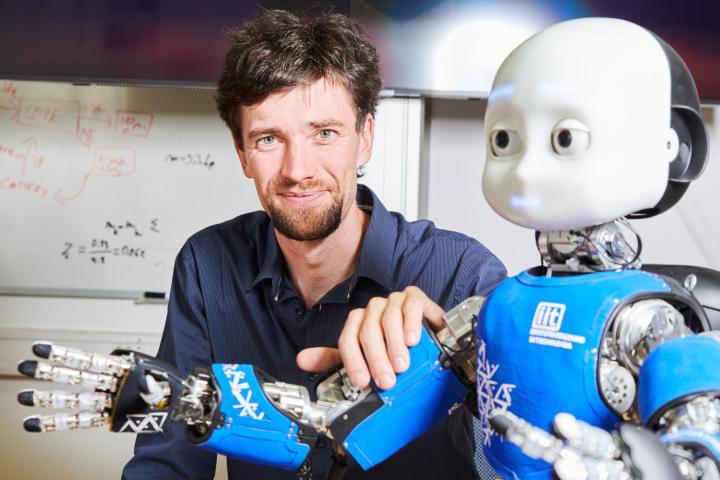
The iCub robot measures just over one metre in height and is the size of a four-year-old child. Instead of joints and muscles, it is controlled by 53 electric motors, two cameras act as its eyes and it perceives sounds through two microphones. What makes it unique, however, is its "touch", which is made possible by four thousand sensors embedded in its electronic skin.
"This is the first robot that can be said to be equipped with all its senses," says Dr Matěj Hoffmann, head of the humanoid robotics group. The group, based at the Department of Cybernetics at the Faculty, was strengthened by iCub in June to further develop new research possibilities in the field of human brain cognition thanks to its features. The child's proportions and the most realistic imitation of human skin to date make it ideal for simulating the processes by which humans acquire tactile knowledge of their surroundings after birth, including learning about their own bodies.
The ability to experience sensation by touch is typical for humans and mammals in general, and our humanoid robots try to emulate these abilities. As a result, the robot can learn to experience the environment in a similar way to how a child learns, and this in turn gives it the potential to develop a similar type of cognition or orientation in space. The robot's learning process is similar to that of a child during the first year of life: it uses touch to create a map of the surface of its body, except that this experience is not written into the child's brain but into an artificial neural network. Matěj Hoffmann, for example, has created one such neural network together with doctoral student Zdeněk Straka. It can be said that this algorithm is directly inspired by the functions of the human brain, and the research draws significantly on current studies in the field of psychology and neuroscience that work directly with humans.
"Our research is based on the scientific notion that having a body is absolutely crucial to human intelligence. Cognition is inseparable from the physical body and its sensory and motor systems, so computational models alone are not enough," says Matěj Hoffmann, who considers humans and mammals in general to be unparalleled in their ability to adapt to environmental conditions in a very short time thanks to their bodies.
Dr. Hofmann's research group wants to help humanoid robots to become closer to humans in their adaptability and to be able to "calibrate" themselves to the conditions of their environment. A prerequisite for this, however, is that they have advanced "senses" so that they can perceive changes in the environment, for example, notice someone entering their surrounding space or be aware of touch. In this area, researchers from the Department of Cybernetics at FEL CTU can already build on the results of their previous research with a modified NAO robot, whose Prague model was also the only one in the world to be equipped with an electronic skin.
One of the consequences of "humanizing" robots may be that they will be able to move autonomously and safely in human populated environments. "We don't want to remake our environment for robots, but instead we want humanoids to be involved in it. Also, because they are similar to us in appearance, they interact with us more naturally than if they were shaped like, say, a box," explains Dr. Hoffmann. The advantage of robotics and its androids in studying these processes is that it takes into account their contact with the environment. In addition, changes or injuries can be simulated on robots that cannot be practiced on human models.
The iCub robot is designed by the Italian Institute of Technology and bears the serial number 47. It is the first robot of its kind in the Czech Republic and runs in an open source environment that anyone can download.
The Prague humanoid was acquired as part of the RCI Research Center Informatics project. "The RCI project supports many aspects of artificial intelligence research, including robotics. In recent years, it has made a significant contribution, among other things, to the success of the DARPA SubT Challenge," adds Prof. Tomáš Svoboda, Head of the Department of Cybernetics at FEL CTU. The cost of the robot is approximately 250 thousand euros (over 6.35 million crowns).
Photo, courtesy of: Petr Neugebauer, FEL CTU